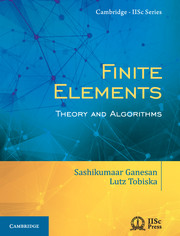Book contents
- Frontmatter
- Contents
- Preface
- 1 Introduction to Sobolev Spaces
- 2 Elliptic scalar problems
- 3 Finite element spaces
- 4 Interpolation and discretization error
- 5 Biharmonic equation
- 6 Parabolic problems
- 7 Systems in solid mechanics
- 8 Systems in fluid mechanics
- 9 Implementation of the finite element method
- Bibliography
- Index
Preface
Published online by Cambridge University Press: 14 December 2017
- Frontmatter
- Contents
- Preface
- 1 Introduction to Sobolev Spaces
- 2 Elliptic scalar problems
- 3 Finite element spaces
- 4 Interpolation and discretization error
- 5 Biharmonic equation
- 6 Parabolic problems
- 7 Systems in solid mechanics
- 8 Systems in fluid mechanics
- 9 Implementation of the finite element method
- Bibliography
- Index
Summary
The purpose of this book is to present—in a coherent and lucid way—the mathematical theory and algorithms of the finite element method, which is the most widely-used method for the solution of partial differential equations in the field of Computational Science. We believe that the full potential of the finite element method can be realised only when the theoretical background and the implemented algorithms are considered as a unit.
The selection of the basic mathematical theory of finite elements in this book is based on lectures given in the “Finite Element I and II” courses offered for several years at Otto-von-Guericke University, Magdeburg and in the “Finite Element I” course offered at the Indian Institute of Science, Bangalore. Furthermore, the finite element algorithms presented are based on the knowledge and experience gained through the development of our in-house finite element package for more than 10 years. The theory and algorithms of finite elements that we describe here are self-contained; our aim is that beginners will find our book to be both readable and useful.
We start in Chapter 1 with a brief introduction to Sobolev spaces and the necessary basics of functional analysis. This will help those readers who are unfamiliar with functional analysis. The goal of Chapter 2 is to explain the finite element method to beginners in the simplest possible way. The concepts of weak solutions, variational formulation of second-order elliptic boundary value problems, incorporation of different boundary conditions in a variational form, and the standard Galerkin approach are all introduced in this chapter. Moreover, existence and uniqueness theory (the Lax-Milgram Theorem) and an abstract error analysis (quasi-optimality of the method) are presented here.
The next two Chapters give the basic theory of the finite element method. In Chapter 3, the construction of finite elements on simplices, quadrilaterals, and hexahedrals is discussed in detail. Furthermore, linear, bilinear and isoparametric transformations are explained, and mapped finite elements are considered. Chapter 4 deals with the interpolation theory of affine equivalent finite elements in Sobolev spaces. We also discuss the interpolation of functions that are less smooth; in particular, Scott-Zhang interpolation is described in this Chapter.
- Type
- Chapter
- Information
- Finite ElementsTheory and Algorithms, pp. vii - viiiPublisher: Cambridge University PressPrint publication year: 2017



